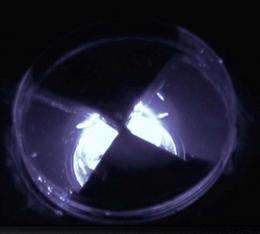Gene causes blue light to have a banana odor

German scientists have succeeded to genetically modify Drosophila (fruit fly) larvae allowing them to smell blue light. The research team can activate single receptor neurons out of 28 olfactory neurons in the larvae for this sensory perception. Normally animals avoid light. However, blue light simulates in genetically modified larvae the smell of an odorant i.e. banana, marzipan or glue, odors which are all present in rotting fruit and attractive to fruit fly larvae.
The team of scientists from Bochum and Göttingen, working under the auspices of Prof. Klemens Störtkuhl, hopes to gain insight into the processing of the neural network. They have published their findings in the international journal Frontiers in Neuroscience Behavior.
The olfactory neurons of the only one millimeter sized genetically modified Drosophila larvae are all capable of producing the protein that is activated by light. The researchers can freely select which of the 28 cells will ultimately be light-sensitive using genetic markers. Prof. Störtkuhl explained that they were able to either activate cells which normally register repulsive odors and subsequently cause an aversion response, or cells that sense attractive odors such as banana, marzipan or glue. The activated neurons send an electrical signal if they are stimulated with blue light at a wavelength of 480 nm. The larva thus has the impression that it perceives odors. The experiment shows that it is possible by inserting photo activated proteins into neurons photo stimulation can produce an olfactory behavior in these larvae , whereas genetically unchanged larvae generally avoid light.
Moreover, the researchers could measure the effect electrophysiologically. Thin electrodes can detect the signal of the light-activated neurons. The transmission of the nerve signal can be followed all the way into the brain, thus enabling non-invasive observation of neural networks. Prof. Störtkuhl pointed out that this method has the great advantage of enabling tests to be carried out on living animals without an injury. The research scientists hope to gain an insight into the network and mode of action of the brain. It must moreover be pointed out that the olfactory sense of the genetically modified fly larvae remains normal.
The researchers now plan to use the same principle to undertake further studies on adult Drosophila, equipping them with photo-activated proteins to cause targeted isolated cerebral neurons to react. These successfully employed methods are now also being used in model systems i.e. mice in other laboratories including a work group at the RUB, to investigate similar issues using mice.
More information: Bellmann D, Richardt A, Freyberger R, Nuwal N, Schwärzel M, Fiala A and Störtkuhl KF (2010) Optogenetically induced olfactory stimulation in Drosophila larvae reveals the neuronal basis of odor-aversion behavior. Front. Behav. Neurosci. 4:27. doi:10.3389/fnbeh.2010.00027
Provided by Ruhr-Universitaet-Bochum
















